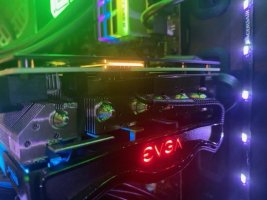GPU was heat soaking my system because the case fans were not ramping as it warmed up. Wanted to share how I linked my case fans to GPU vs. CPU temp without resorting to resource hogging/conflicting software like iCue.
System is built around an Asus Hero motherboard and related BIOS (assume that most other manufacturers have similar functionalities as described). All fan, RGB, and AIO functionalities are now hardware coded and no longer need to run background widgets at start-up. RGB set to indicate AIO fluid temp on the waterblock and fans; GPU, VRAM, and VRM temps along the EVGA rainbow bar; and some bling on RAM and keyboard (GSkill, Corsair).
Hardware/Install
1. Purchase $6 T-Sensor from Amazon https://www.amazon.com/gp/product/B00CMR38LC?psc=1
2. Attach T-Sensor to designated motherboard header
3. Route cable and Insert probe of T-Sensor into fins of GPU heatsink
BIOS Adjustments
4. Change case fans' input sensor from CPU thermal to T-Sensor
5. Add 12 second ramp down for fans (basically hysteresis).
6. Adjust case fan curves to ramp based on T-Sensor readings
Software Adjustments
7. Hardware encode AIO and Keyboard RGB in iCue then disable programs on start-up.
System is built around an Asus Hero motherboard and related BIOS (assume that most other manufacturers have similar functionalities as described). All fan, RGB, and AIO functionalities are now hardware coded and no longer need to run background widgets at start-up. RGB set to indicate AIO fluid temp on the waterblock and fans; GPU, VRAM, and VRM temps along the EVGA rainbow bar; and some bling on RAM and keyboard (GSkill, Corsair).
Hardware/Install
1. Purchase $6 T-Sensor from Amazon https://www.amazon.com/gp/product/B00CMR38LC?psc=1
2. Attach T-Sensor to designated motherboard header
3. Route cable and Insert probe of T-Sensor into fins of GPU heatsink
BIOS Adjustments
4. Change case fans' input sensor from CPU thermal to T-Sensor
5. Add 12 second ramp down for fans (basically hysteresis).
6. Adjust case fan curves to ramp based on T-Sensor readings
Software Adjustments
7. Hardware encode AIO and Keyboard RGB in iCue then disable programs on start-up.
Attachments
Last edited:












